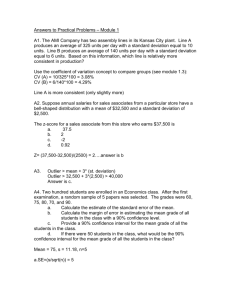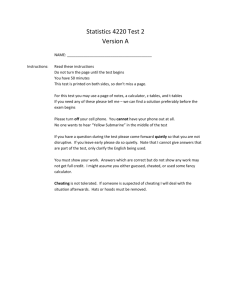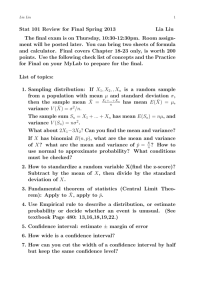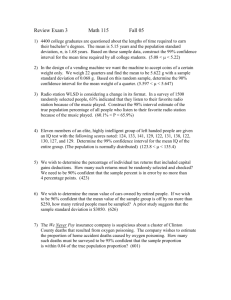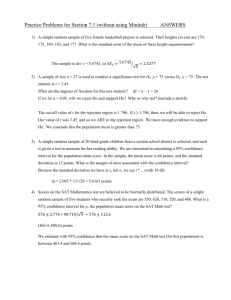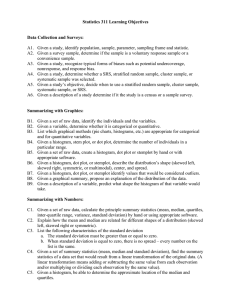Final Exam Review - The University of North Carolina at Chapel Hill
advertisement
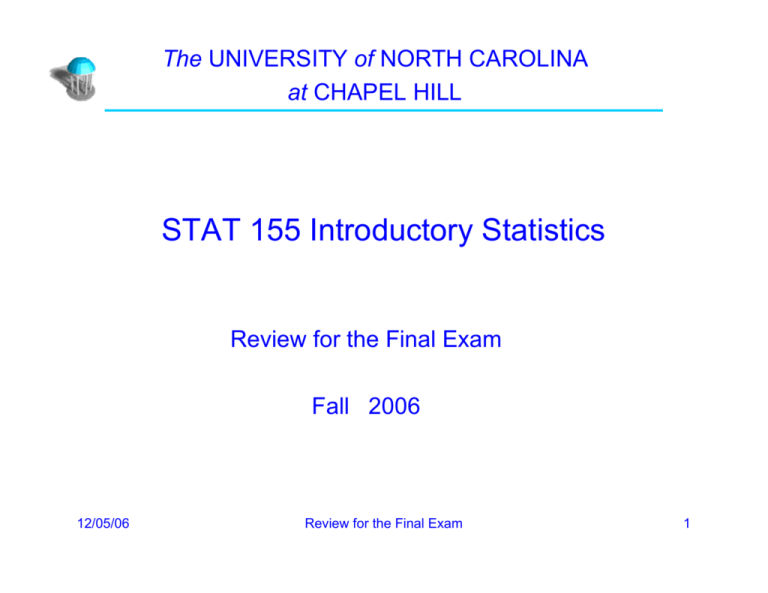
The UNIVERSITY of NORTH CAROLINA at CHAPEL HILL STAT 155 Introductory Statistics Review for the Final Exam Fall 2006 12/05/06 Review for the Final Exam 1 Final Exam Format • • • • • • Closed-book, closed-notes One formula sheet (double-sided) Calculator Scantron and #2 pencils Tables will be provided 50 multiple-choice questions --- at least a half based on materials covered after the 2nd midterm 12/05/06 Review for the Final Exam 2 Suggestions for your review • Read the lecture notes carefully. • Go over – Homework problems; – practice midterms and midterms. (Solve the problems yourself!) • Do the practice problems in this final review. 12/05/06 Review for the Final Exam 3 Office hours • Monday 12/11 --- Wednesday 12/13 11 am --- 1 pm Solutions to Hwk 22: available at Blackboard from Thursday 12/7 12/05/06 Review for the Final Exam 4 What have we learned in STAT 155? • • • • • • Basic data analysis techniques Simple linear regression Elementary probability Sampling distributions Point estimation & confidence intervals Hypothesis testing (Z test) 12/05/06 Review for the Final Exam 5 Review of Chapter 1 • Visualization tools: – stem-and-leaf, histogram, bar graph, pie chart, boxplot, time plot • Measures of Location: – mean, median, mode • Measures of Variability: – range, interquartile range, standard deviation, variance • The five-number summary • Effect of linear transformation • Normal distribution: – Standardization, normal distribution calculation 12/05/06 Review for the Final Exam 6 Review of Chapter 2 • Scatterplots: interpretation. • Correlation: definition and properties • Least-Squares Regression: – Find the regression equation, prediction and interpretation, the meaning of r2 • Regression diagnostics: – Residuals, outliers, influential observations, lurking variables 12/05/06 Review for the Final Exam 7 Review of Chapter 4 • Sample spaces, events, union, intersection, complement, disjoint events, tree diagram, Venn diagram • Axioms and properties of probability • Addition rule: P(A ∪ B) = P(A) + P(B) - P(A ∩ B) • Conditional probability: P(A | B) = P(A ∩ B) / P(B) • Multiplication rule: P(A ∩ B) = P(A | B) P(B) = P(B | A) P(A) • Independence: P(A ∩ B) = P(A) P(B) • Bayes rule: no need to memorize … derive it ! • Rules for expected values & variances 12/05/06 Review for the Final Exam 8 Review of Chapter 5 • Binomial distribution – Sampling distribution for counts and proportions – Table C, mean, standard deviation – Normal approximation (continuity correction) • Sampling distribution of X 1. µ X = µ X ; σ X2 = σ X2 n 2. (i). If X is normal, X is normal. (ii). If X is nonnormal, X is approximately normally distributed for sufficiently large sample size. 12/05/06 Review for the Final Exam 9 Road map for CI and HT (Lectures 18 – 22) • • • • • • • • • • • 1 sample or two samples? 1 sample: ö or p ? 2 samples: ö1 à ö2 or p1 à p2 ? CI or HT ? For p1 à p2 : use SED or SEDp ? Ha : 1-sided or 2-sided? Which P-value to calculate ? Decision: reject or accept H0 ? CI: what is the margin of error? HT: which 4 steps ? Relationship between CI and HT ? 12/05/06 Review for the Final Exam 10 Practice Problem 1 • A fair coin is tossed 200 times, what is the probability that the total number of heads is between 95 and 105? • • • • X ~ Bin(200, 0.5); Want: P(95 ≤ X ≤ 105) Need to use normal approximation µX = 200 × 0.5 = 100, σX = (200 × 0.5 × 0.5)1/2 = 7.07 P(95 ≤ X ≤ 105) = P(X ≤ 105) - P(X ≤ 94) ≈ P[ (94 + .5 - 100) / 7.07 ≤ Z ≤ (105 + .5 - 100) / 7.07 ] = 0.7823 – 0.2177 = 0.5646. 12/05/06 Review for the Final Exam 11 Practice Problem 2 • Suppose 9 observations are drawn from a normal population whose standard deviation is 2. The observations are: 15, 9, 13, 11, 8, 12, 13, 8, 10 • At significance level 0.05, you want to determine whether the mean of the population from which this sample ( x = 11 ) was taken is significantly different from 10. – – – – State the null and alternative hypotheses in symbols. Compute the value of the test statistic. Compute the p-value. Interpret the results. • Answers: – H0: µ = 10 vs. Ha: µ ≠ 10. – z = 1.5 and p-value = 0.1336 – We do not reject H0 … Not enough evidence. 12/05/06 Review for the Final Exam 12 Practice Problem 3 • Professors Smith and Jones are both planning studies of serum glucose levels in Martians. The serum glucose levels are known to follow a normal distribution with a standard deviation of 5 units. Each professor plans to measure a random sample of Martians and to construct a 90% confidence interval for the mean Martian serum glucose level µ. The sample size will be: Smith: n = 30; Jones: n = 300. • Assume that the population of Martians is very large. Q1: Would we expect Jones' confidence interval to be narrower than, wider than, or about the same width as Smith's confidence interval? Q2: Is the chance that Jones' confidence interval contains µ less than, more than, or the same as the chance that Smith's confidence interval contains µ? 12/05/06 Review for the Final Exam 13 Practice Problem 4 • A multiple choice exam has 100 questions. Each question has 4 possible answers, of which only one is correct. (a) What is the expected number of correct answers by sheer guesswork? (b) What is the probability that sheer guesswork will yield at least 30 correct answers? • Answer: (a) 100 × (1/4) = 25 (b) 30 − 0.5 − 25 P( X ≥ 30) ≈ P( Z > ) = P( Z > 1.04) = 0.1492. 1 3 100 ⋅ ⋅ 4 4 12/05/06 Review for the Final Exam 14 For Lectures 18 -- 22 • Review Hwk 18 --- 22 problems … 12/05/06 Review for the Final Exam 15




